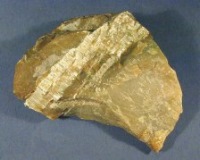Asbestos is a naturally occurring fibrous mineral. It is mined and processed like other minerals. It is popular for it’s binding, insulating, heat and chemical resisting properties. The three most common types of asbestos are: chrysotile, amosite, and crocidolite. Chrysotile is the most common, used in hundreds of different applications.
Asbestos is made of microscopic bundles of fibers. These bundles can be broken down into fibers 700 times smaller than the diameter of a human hair.
Asbestos Images:
 Asbestos in mineral form
Asbestos in mineral form
 Microscopic view of Asbestos fibers
Microscopic view of Asbestos fibers
Asbestos can be found in over 3,000 construction products. Many of these products were produced in the past, but are still in place in many previously built buildings and structures. Asbestos was used in insulation, drywall as a binding agent, pipe system insulation, surfacing materials like spray-on fire proofing for beams and ceilings. It is also used for fire doors and heat barriers, and is in special fabrics and textiles. Asbestos fibers can be found in many adhesives and even in roofing products. Asbestos is still used in transportation in brake linings on airplanes, large trucks, and tractors.
The term “friable” means that the material can be crumbled or reduced to powder by hand pressure when dry. CSU has both friable and non-friable ACM’s (Asbestos Containing Materials) in buildings.
Examples of friable ACM are: ceiling tiles, pipe insulation (TSI) on steam systems and boilers, blown insulation, duct work insulation, and spray-on fire proofing.
Examples of non-friable ACM are: floor tiles, adhesives, roofing products, flexible duct connectors, transite panels and counter tops. It’s even in some lab gloves to insulate against extreme heat. There are transite pipes buried on campus carrying steam and water.
Asbestos is made up of microscopic bundles of fibers that may become airborne when disturbed. These fibers get into the air and may be inhaled into the lungs, where they may cause health problems. Inhalation is the only method of entry that has been proven to cause adverse health effects. Most of the fibers get trapped in the nose, throat or trachea. Fibers in these areas are expelled when you cough, sneeze or blow your nose. When fibers reach the lungs, damage may occur. The Alveoli (tiny air sacs in lungs) are especially susceptible.
As asbestos fibers are inhaled, they may become trapped in the lung tissue. The body tries to dissolve the fibers by producing an acid. This acid, due to the chemical resistance of the fiber, does little to damage the fiber, but may scar the surrounding tissue. Eventually, this scarring may become so severe that the lungs cannot function. Health threats as extreme as this usually take repeat exposures at abnormally high concentration levels. Repeated or high dose exposures can lead to a disease known as asbestosis. This disease is very debilitating and the latency period is often 20-40 years. Smoking may greatly increase cancers associated with asbestos inhalation exposures.